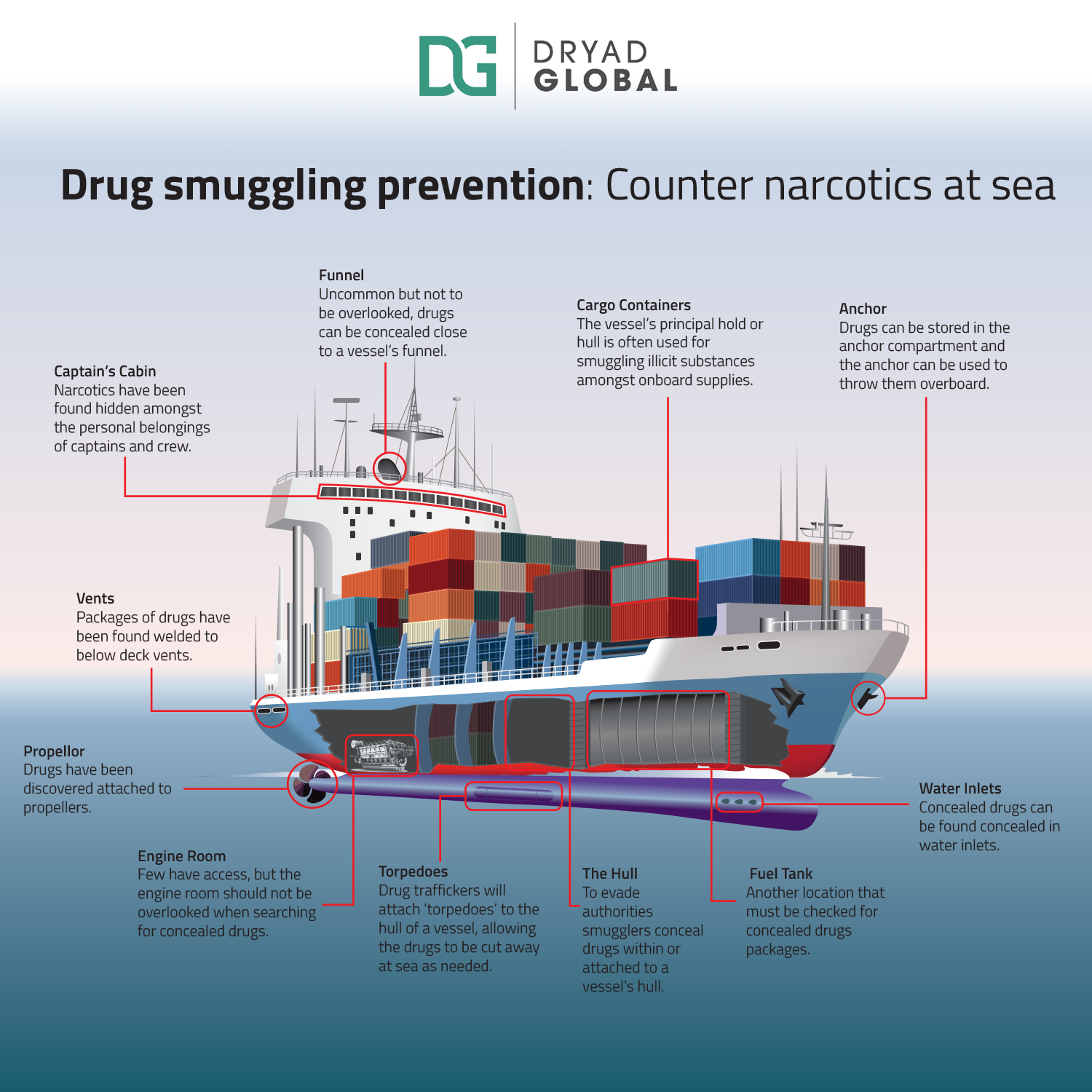4 min read
The Role South American Authorities play in preventing drug trafficking to Europe
By: Dryad Global on June 10, 2024 at 9:20 AM

Recent operations across South America have highlighted the escalating battle against narcotics trafficking within the region.
Significant drug seizures in Peru, Ecuador, and Panama underscore the pervasive nature of drug smuggling networks and the concerted efforts by national authorities to combat this illicit trade. These operations not only reflect the increasing volume of drug trafficking but also the sophisticated methods employed by traffickers to evade detection. This analysis examines the major drug interdictions in the past weeks and evaluates their implications on regional security and international narcotics control efforts.
Peru’s Operation “Mixtura” in the Port of Callao
In a notable operation dubbed "Mixtura," the National Police of Peru (PNP), alongside the Public Ministry and National Customs Superintendency (Sunat), successfully intercepted over 449 kilograms of cocaine alkaloid destined for the Netherlands. Conducted at the port of Callao, this operation involved advanced intelligence and the use of sophisticated scanning technology to inspect a suspicious container from Mexico. The drugs were concealed within nine bags and three suitcases labeled as medicine, showcasing the intricate concealment strategies employed by traffickers. This seizure underscores Peru’s significant role as a transshipment point in the global drug trade and highlights the critical need for continuous enhancement of port security measures and international cooperation.
Major Drug Seizure Near San Cristóbal Island, Galapagos
In a parallel effort, the Armed Forces of Ecuador achieved a significant victory against drug trafficking networks by intercepting 1.5 tons of controlled substances southwest of San Cristóbal Island in the Galapagos. The Ecuadorian Navy played a pivotal role in this operation, which saw the capture of 38 packages of narcotics. This operation not only represents a considerable blow to drug trafficking networks but also underscores Ecuador’s commitment to safeguarding its maritime borders. The strategic location of the Galapagos Islands makes them a critical point for monitoring and controlling illicit maritime activities, emphasizing the necessity for robust maritime patrols and surveillance systems.
Drug Interdiction on the Panamanian Atlantic Coast
Further north, Panamanian authorities seized 100 packages of drugs, believed to be cocaine, hidden within briefcases inside a container at a port on the Atlantic coast. This seizure highlights Panama’s strategic importance as a transit hub for narcotics flowing from South America to other continents. The drugs originated from New Zealand and were destined for Spain, revealing the global nature of the trafficking routes. The cooperation between the National Police and the Public Ministry in this operation demonstrates the effectiveness of coordinated national efforts in disrupting drug trafficking networks.
Ecuador’s Operation “Poseidon XIII” and the Discovery in Guayas
Ecuadorian police, in the framework of Operation “Poseidon XIII,” discovered a ton of cocaine hydrochloride in a commercial cargo container of cocoa destined for Bulgaria. The seizure occurred in Guayas province, with the detection made possible by specialized police units and drug-sniffing dogs. This operation led to the arrest of the legal representative of the exporting company and the truck driver, both Ecuadorians with no prior criminal records. This incident highlights the adaptive nature of traffickers who exploit legitimate commercial channels to smuggle drugs. Ecuador’s proximity to Colombia and Peru, the world’s largest cocaine producers, positions it as a critical juncture in the narcotics supply chain, necessitating vigilant port security and international cooperation.
Implications for Regional and International Drug Control
These recent operations across Peru, Ecuador, and Panama illustrate the widespread and entrenched nature of drug trafficking networks in South America. The substantial quantities of narcotics intercepted reflect the region’s pivotal role in supplying major consumer markets in Europe and North America. The diversity of routes and methods, from hidden compartments in commercial containers to the use of maritime spaces, indicates a high level of sophistication among trafficking organizations.
Strategic Importance of Maritime Security
The seizures highlight the importance of maritime security in combating drug trafficking. The operations near the Galapagos and Panama underscore the need for comprehensive maritime surveillance and international cooperation. Given the strategic locations of these regions, enhancing naval capabilities and intelligence-sharing mechanisms is crucial for intercepting illicit shipments before they reach international waters.
Enhancing Port Security Measures
The interdiction efforts in the ports of Callao and Guayas emphasize the necessity for advanced port security measures. The use of cutting-edge technology, such as high-resolution scanners and chemical detection devices, proved instrumental in these operations. Investing in such technologies and training personnel in their effective deployment can significantly enhance the detection capabilities of port authorities.
International Cooperation and Information Sharing
The transnational nature of drug trafficking underscores the need for robust international cooperation. Sharing intelligence and coordinating operations between countries can lead to more effective disruption of trafficking networks. Initiatives like joint task forces and collaborative training programs can foster stronger alliances and improve operational effectiveness.
Conclusion
The recent drug seizures in Peru, Ecuador, and Panama highlight the persistent challenge of narcotics trafficking in South America. The successful interdictions demonstrate the effectiveness of coordinated efforts and advanced technologies in combating this illicit trade. However, the sophistication and adaptability of traffickers necessitate continuous enhancement of security measures and international cooperation. By bolstering maritime security, enhancing port detection capabilities, and fostering international partnerships, South American countries can more effectively counter the pervasive threat of drug trafficking and contribute to global narcotics control efforts.
Sources: Radio nacional, TCtelevision, La prensa , Swiss Info
Related Posts
TANKERS: Separate anti-piracy payments shelved
S&P Global - The slump in MR tanker rates have wiped away most of the additional anti-piracy..
Houthis renege on new deal to prevent Red Sea oil..
The Iran-backed Houthi militia in Yemen on Sunday reneged on a deal to head off an environmental..
Shippers unlikely to see lower insurance premiums..
Shipowners and charterers carrying commodities in the Indian Ocean are unlikely to see lower..




